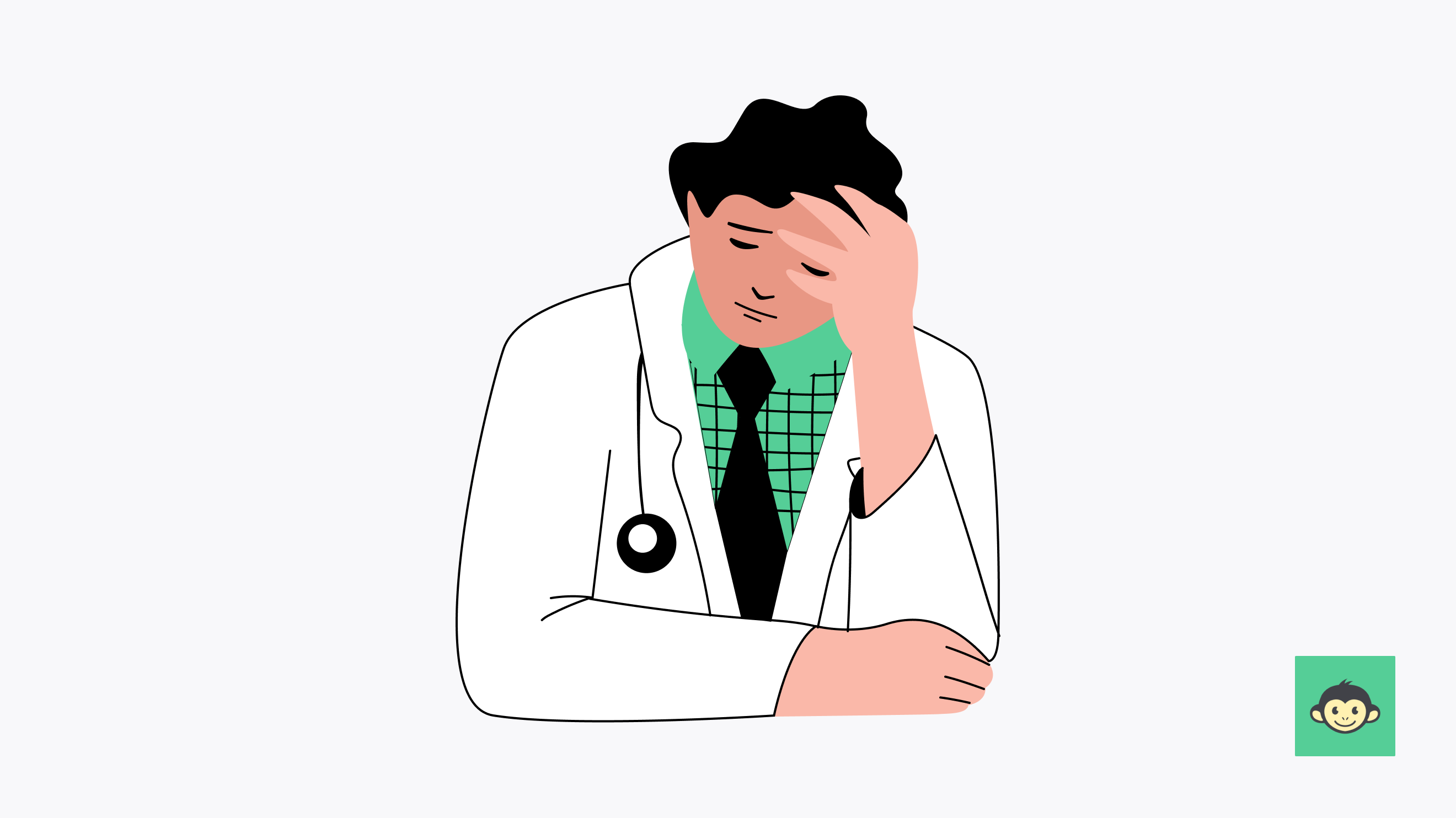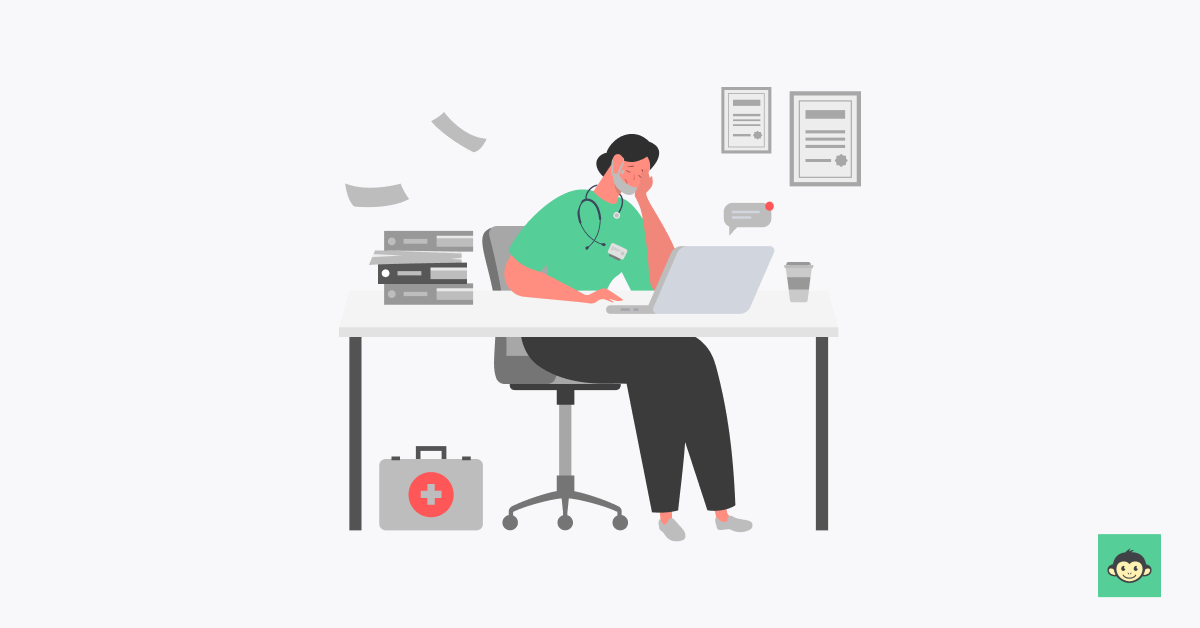How to prevent burnout for healthcare employees: Top tips and practices to try in 2024

Healthcare workers are the backbone of our medical system, dedicating themselves to the well-being of others. However, this dedication can come at a cost.
The relentless pace, emotional exhaustion, prolonged workplace stress, and exposure to difficult situations can lead to burnout – a state of exhaustion, cynicism, and reduced effectiveness. In 2024, let's prioritize the well-being of those who care for us.
This blog will equip you with the knowledge and tools to prevent burnout. We'll explore the top tips, strategies, and best practices healthcare employees can implement this year.
From using basic self-care techniques and setting boundaries to fostering supportive work environments, we'll guide you on how to create a sustainable and rewarding career path.
By prioritizing their own well-being, healthcare workers can continue to deliver exceptional care and avoid the pitfalls of burnout.
How common is burnout in healthcare workers?

Burnout among healthcare workers is, unfortunately, quite common and has been recognized as a significant issue by healthcare employers globally.
The demanding nature of the healthcare profession, including long hours, high-stress levels, heavy workloads, and emotional strain, can contribute to burnout.
According to various studies and surveys, the prevalence of burnout among healthcare workers varies across different specialties and regions. However, in general, it is consistently reported to be high.
For instance, a systematic review and meta-analysis published in JAMA Network Open in 2019 found that the overall prevalence of burnout among physicians worldwide was 44%. Another study published in the same journal in 2018 reported that the prevalence of burnout among nurses in the United States was around 35%.
Why has reducing burnout for healthcare professionals become more important than ever?

Reducing burnout among workers in healthcare systems has become more important than ever, post the pandemic era for several reasons:
1. Impact on patient care
Burnout among healthcare workers can lead to decreased quality of patient care, including medical errors, lower patient satisfaction, and compromised safety. Addressing and preventing burnout in healthcare is essential for maintaining high standards of care and ensuring positive patient outcomes.
2. Healthcare worker well-being
Burnout negatively affects the physical and mental health of healthcare professionals. It can lead to increased rates of depression, anxiety, substance abuse, and other mental health issues. Improving healthcare worker well-being is not only a matter of compassion but also a necessity for sustaining a capable and resilient workforce.
3. Workforce retention and recruitment
Burnout contributes to high rates of turnover and early retirement among healthcare workers. The demanding nature of the profession, combined with burnout, leads many individuals to reconsider their career choices or leave the healthcare field altogether.
Addressing burnout through healthcare or occupational health psychology is crucial for retaining experienced professionals and attracting new talent to the healthcare workforce.
4. Costs to healthcare systems
Burnout imposes significant costs on health care systems due to reduced professional efficacy, absenteeism, turnover-related expenses, and healthcare utilization for treating mental health issues among healthcare workers.
By reducing burnout, healthcare organizations can improve efficiency and reduce financial strain on the health care system.
5. Public health preparedness
A resilient and well-supported healthcare workforce is essential for effectively responding to public health crises such as pandemics or natural disasters.
Burnout weakens the healthcare system's capacity to respond to emergencies by exacerbating existing workforce shortages and impairing healthcare professionals's ability to perform their duties effectively.
6. Ethical imperative
Healthcare workers dedicate themselves to caring for others and often prioritize patient needs above their own.
Addressing burnout is a matter of ethical responsibility to support those who devote their careers to the service of others and ensure they receive the care and professional support that they need to thrive in their roles.
What are the leading causes of burnout in healthcare?

The leading causes of healthcare burnout are multifaceted and often stem from various factors within the work environment and personal factors. Some of the primary causes of burnout set to include:
High workload
Healthcare professionals often face heavy workloads with demanding schedules, long hours, and limited time for breaks. The pressure to see a high volume of patients or handle numerous responsibilities within a limited timeframe can contribute significantly to burnout.
Emotional and mental stress
Healthcare workers frequently encounter emotionally challenging situations, including dealing with patient suffering, traumatic events, end-of-life care, and difficult conversations with patients and their families.
The emotional toll of these experiences, combined with the responsibility of providing compassionate care, can lead to burnout.
“Around 40% of intensive care unit (ICU) health workers met the threshold for probable post-traumatic stress disorder (PTSD) during the COVID-19 pandemic.” (Source)
Lack of control and autonomy
Feeling a lack of control over work processes, decision-making, and patient care can contribute to feelings of frustration and burnout among healthcare professionals.
Limited autonomy can make it difficult for individuals to implement changes or improvements in their work environment, leading to feelings of powerlessness.
Administrative burden
Healthcare professionals often face significant administrative burdens, including paperwork, documentation requirements, electronic health record (EHR) tasks, and bureaucratic processes. Tools such as the best EHR for mental health private practice can help ease these challenges. Similarly, healthcare organizations can gather real-time insights using HIPAA-compliant survey software to assess employee well-being and improve working conditions.
Spending excessive time on administrative tasks detracts from time spent with patients and can contribute to feelings of inefficiency and burnout.
Work-life imbalance
Balancing the demands of a healthcare career with personal life responsibilities can be challenging. Long hours, irregular schedules, and on-call duties can disrupt family time, social relationships, and self-care activities, leading to burnout.
Interpersonal conflict and poor workplace culture
Workplace dynamics, including conflicts with colleagues or supervisors, lack of support from management, and toxic work culture, can contribute to feelings of burnout.
A lack of teamwork, communication breakdowns, and a perceived lack of appreciation can erode both one's job satisfaction and morale.
Career dissatisfaction and lack of recognition
Feeling undervalued, unrecognized for contributions, or lacking opportunities for professional growth and advancement can lead to burnout.
Healthcare professionals who perceive their work as monotonous, unfulfilling, or lacking in meaning may experience decreased job satisfaction and increased burnout risk.
What are the best practices for managing and preventing healthcare provider burnout?

Managing and preventing burnout among healthcare providers requires a comprehensive approach that addresses both individual and organizational psychology. Here are some best practices:
- Promote work-life balance: Encourage healthcare providers to maintain a healthy balance between work and personal life. Implement policies that support flexible scheduling, adequate time off, and opportunities for relaxation and self-care.
- Provide resources for stress management: Offer resources and programs to help healthcare providers manage stress effectively. This may include access to counseling services, mindfulness training, stress reduction workshops, and relaxation techniques.
- Foster a supportive work environment: Create a culture of support and collaboration within the healthcare organization. Encourage open communication, teamwork, and mutual respect among colleagues. Provide opportunities for peer support and debriefing sessions after challenging patient encounters.
- Address workload issues: Assess and address workload issues that contribute to burnout. This may involve optimizing staffing levels, redistributing tasks, streamlining workflows, and implementing technology solutions to reduce administrative burdens.
- Offer professional development opportunities: Provide opportunities for professional growth and development to help healthcare providers feel engaged and fulfilled in their work. Offer training programs, mentorship opportunities, and career advancement pathways.
- Recognize and reward contributions: Acknowledge the hard work and dedication of healthcare providers through recognition programs, awards, and incentives. Show appreciation for their contributions to patient care and the organization's mission.
- Encourage self-care practices: Educate healthcare providers about the importance of self-care and encourage them to prioritize their physical and mental well-being. Promote healthy lifestyle habits such as regular exercise, nutritious diet, adequate sleep, and relaxation techniques.
- Implement wellness initiatives: Develop wellness initiatives tailored to the needs of healthcare providers. This may include wellness challenges, fitness programs, on-site yoga or meditation classes, and access to healthy snacks and beverages.
- Regularly assess and monitor burnout: Conduct regular assessments to monitor levels of burnout among healthcare providers and identify areas for improvement. Use validated assessment tools such as the Maslach Burnout Inventory (MBI) to measure burnout levels accurately.
- Leadership support and role modeling: Demonstrate leadership support for addressing burnout and promoting well-being within the organization. Leaders should prioritize employee health and model healthy behaviors themselves.
Top 10 strategies to prevent burnout and emotional exhaustion in healthcare

By implementing the following strategies, healthcare organizations can further enhance their efforts to prevent burnout and support the well-being of their providers, ultimately improving patient care and organizational resilience.
- Encourage peer support groups: Facilitate the formation of peer support groups or mentorship programs where healthcare providers can connect with colleagues who understand their challenges and offer mutual support and encouragement.
- Offer employee assistance programs (EAPs): Provide access to confidential counseling services and mental health support through Employee Assistance Programs. EAPs can help healthcare providers address personal and work-related stressors, reducing the risk of burnout.
- Implement flexible work arrangements: Allow healthcare providers to have flexibility in their work arrangements, such as telecommuting options, flexible hours, or compressed workweeks. Flexible arrangements can help accommodate individual needs and preferences, promoting work-life balance and reducing burnout.
- Address trauma and compassion fatigue: Provide training and support to help healthcare providers cope with the emotional toll of their work, including exposure to trauma and compassion fatigue. Equip providers with strategies for self-care and resilience in the face of challenging situations.
- Evaluate organizational policies and practices: Regularly review organizational policies, practices, and workflows to identify and address factors contributing to burnout. Solicit feedback from healthcare providers and make adjustments as needed to create a supportive and sustainable work environment.
- Promote physical wellness initiatives: Encourage healthcare providers to prioritize their physical health by offering wellness initiatives such as fitness challenges, healthy eating programs, and on-site exercise facilities. Physical health wellness is closely linked to overall well-being and resilience against burnout.
- Promote autonomy and control: Empower healthcare providers by involving them in decision-making processes and giving them autonomy and control over their work whenever possible. Feeling empowered and valued can increase job satisfaction and reduce burnout.
- Help in workload prioritization: Help healthcare providers prioritize tasks and manage their workload effectively. Encourage them to focus on high-priority activities and delegate tasks when appropriate to prevent feeling overwhelmed.
- Promote organizational resilience: Foster a culture of resilience within healthcare organizations by encouraging adaptive leadership, promoting problem-solving skills, and fostering a sense of collective responsibility for overcoming challenges. Building organizational resilience can help healthcare providers navigate stressful situations more effectively and reduce burnout risk.
- Promote a culture of continuous improvement: Encourage a culture of learning and continuous improvement within healthcare organizations. Provide opportunities for professional development, quality improvement projects, and innovation initiatives that engage healthcare providers and foster a sense of purpose and fulfillment in their work.
Significance of pulse surveys in preventing burnout for healthcare employees

Pulse surveys play a significant role in preventing burnout among healthcare employees by providing timely insights into their well-being and work experiences.
These brief and frequent surveys allow healthcare organizations to gauge employee morale, identify warning signs and sources of stress, and assess the effectiveness of existing support initiatives.
By regularly collecting feedback through pulse surveys, organizations can promptly detect early signs of burnout and take proactive measures to address mental health concerns. One key significance of pulse surveys is their ability to capture real-time data on the dynamic nature of burnout within healthcare settings.
Unlike traditional annual surveys, pulse surveys offer a more agile and responsive approach to monitoring employee engagement and satisfaction. This agility enables organizations to adapt their strategies quickly and tailor interventions to meet the evolving needs of their workforce.
Additionally, pulse surveys promote transparency and open communication between healthcare employees and leadership. By soliciting anonymous feedback on a regular basis, organizations demonstrate their commitment to listening to the concerns of their employees and prioritizing their well-being.
This fosters a culture of trust and collaboration, where employees feel valued and supported in addressing challenges related to burnout and workplace stress.
Furthermore, pulse surveys empower healthcare organizations to track progress over time and evaluate the effectiveness of interventions aimed at preventing burnout.
By comparing survey results longitudinally, organizations can identify trends, measure the impact of initiatives, and make data-driven decisions to continuously improve their support strategies.
Conclusion
Preventing burnout among healthcare employees is paramount for maintaining a resilient and effective workforce, ultimately enhancing patient care and organizational performance.
By implementing a comprehensive approach that includes strategies such as promoting work-life balance, providing resources for self-care, and leveraging pulse surveys for real-time feedback, healthcare organizations can proactively address burnout and support the well-being of their employees.
CultureMonkey's pulse survey emerges as the ultimate solution for continuously monitoring employee well-being. With its real-time insights and anonymous feedback mechanisms, CultureMonkey empowers healthcare organizations to proactively address burnout and prioritize employee wellness.
Recognizing the significance of health worker burnout prevention not only improves employee moral injury and retention but also ensures the delivery of high-quality care and sustains the long-term viability of healthcare systems.



